Indoor vs. Outdoor Bridge Cranes: Which is Right for You?
Choosing between an indoor bridge crane and an outdoor bridge crane depends on your workspace, load requirements, and environmental conditions. This guide compares their features, benefits, and ideal applications to help you make the best decision.

1. Key Differences Between Indoor and Outdoor Bridge Cranes
1.1 What is an Indoor Bridge Crane?
An indoor overhead crane is designed for enclosed spaces like factories, warehouses, and workshops. It operates on fixed runways and is ideal for:
- Precision material handling in manufacturing
- Heavy lifting in confined areas (e.g., assembly lines)
- Workshops with limited ceiling height
Common types:
1.2 What is an Outdoor Bridge Crane?
An outdoor overhead crane is built to withstand harsh weather (rain, wind, extreme temperatures). It’s commonly used in:
- Shipyards & ports
- Construction sites
- Steel mills & lumber yards
Key features:
- Weather-resistant coatings (anti-corrosion)
- Higher wind resistance (per ANSI/CMAA standards)
2. How to Choose: Indoor or Outdoor Bridge Crane?
2.1 Load Capacity & Span Requirements
- Indoor bridge cranes typically handle 1-20 tons, with spans under 30m.
- Outdoor bridge cranes support 5-100+ tons, with longer spans (50m+).
Tip: If you need high-capacity lifting in a controlled environment, a double-girder indoor crane may be best.
2.2 Environmental Factors
| Factor | Indoor Bridge Crane | Outdoor Bridge Crane |
|---|---|---|
| Weather Resistance | Not required | Essential (corrosion-proof steel) |
| Temperature Range | Stable (15°C–30°C) | Extreme (-30°C to 50°C) |
| Wind Load | Minimal impact | Must meet ANSI B30.2 standards |
Decision point: If your site has high humidity, saltwater exposure, or heavy winds, an outdoor crane is necessary.
2.3 Cost & Installation
- Indoor cranes are cheaper (no weatherproofing needed).
- Outdoor cranes require higher upfront costs (foundations, coatings).
Example: A 5-ton indoor bridge crane costs 15,000–15,000–30,000, while an outdoor version may cost 25,000–25,000–50,000+.
3. Success Story: How [Company Germany] Improved Efficiency with the Right Crane
Challenge: A metal fabrication workshop struggled with slow material movement between stations.
Solution: They installed a 10-ton indoor bridge crane with radio remote control, reducing lifting time by 40%.
Result:
- 25% faster production cycles
- Zero weather-related downtime (since it’s indoors)
Key Takeaway: If your operations are indoors, a customized bridge crane can maximize efficiency.
4. FAQs: Indoor vs. Outdoor Bridge Cranes
4.1 Can an Indoor Crane Be Used Outdoors?
No—indoor cranes lack weather protection and may corrode or malfunction in rain/snow.
4.2 Which is More Durable?
Outdoor cranes are built tougher, but indoor cranes last longer in controlled environments.
4.3 What’s the Best Crane for a Small Workshop?
A single-girder indoor bridge crane (1-5 tons) is cost-effective for small spaces.
5. Conclusion: Make the Right Choice
- Choose an indoor bridge crane if you work in a factory, warehouse, or workshop.
- Opt for an outdoor bridge crane if you face harsh weather or heavy-duty lifting.
Need help deciding? Get a free consultation to find the perfect crane for your needs!
All News
Recent Posts
2025/1/25
2025/2/7
2024/8/1
Contact Us Now
Have questions about our cranes or need help?
Reach out to our friendly team for expert support and guidance.
We are here to help you power your journey towards a greener future !
Address: Crane Industry Park, Xinxiang City Henan Provice



